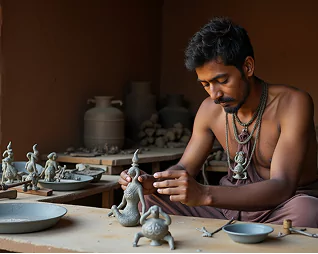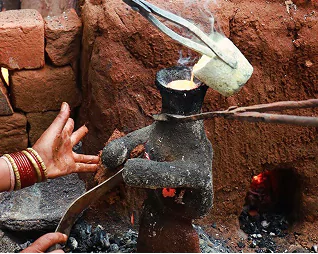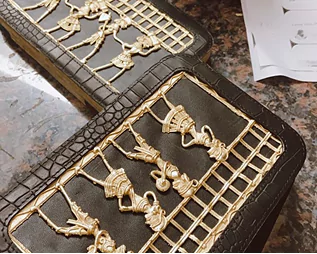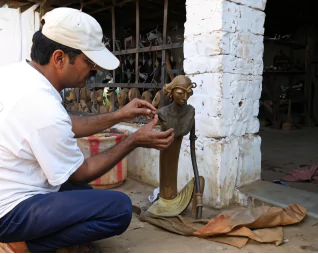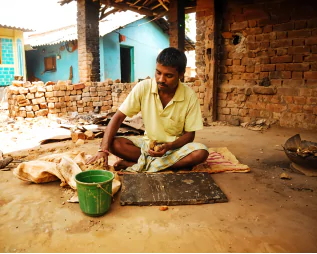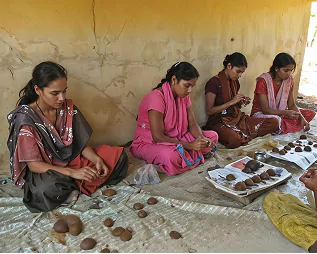History of Baster Art
Bastar Art
Bastar tribal art is a unique and heritage-inspired art type rooted in daily life and honed over generations of consistent handcrafting techniques.
-
1. Chhattisgarh


Process Of Making Bastar Artefacts

The Artful Journey Of Timeless Creations
Gathering the Raw Material: Recycled iron scrap from homes and markets is collected, forming the sustainable foundation for every Bastar art creation.
Heating in the Furnace: Scrap iron is fired in the Dhukna Sar (furnace) until glowing hot, ready for transformation under skilled artisan hands.
Shaping with Tools: Artisans hammer, cut, and chisel the heated iron, carefully crafting desired forms without casting or moulding techniques.
Detailing and Refining Edges: Sharp portions are trimmed, surfaces filed smooth, and intricate designs are added using chisels and tongs.
Finishing with Varnish: A protective varnish coat is applied, enhancing shine and ensuring both beauty and durability of the finished artefact.

Enjoy 15% Off
Bring home timeless Bastar craftsmanship. Use this discount code today and own handcrafted iron art pieces that celebrate tradition, artistry, and cultural pride.
Our Bestselling Bastar Art Products
Discover our best-selling Bastar art pieces, handcrafted with traditional materials and age-old techniques. Adorn your home with Bastar artefacts and be a part of the eternal legacy of India's rich heritage.
-
Brass Bastar Tribal Dance W...
(20% Off)Regular price₹ 5,568.00₹ 5,568.00Unit price per₹ 6,960.00Regular priceSale price -
Bastar Hand-painted Iron Cr...
(15% Off)Regular price₹ 4,123.00₹ 4,123.00Unit price per₹ 4,850.00Regular priceSale price -
Bastar Hand-Painted Iron Cr...
(15% Off)Regular price₹ 4,760.00₹ 4,760.00Unit price per₹ 5,600.00Regular priceSale price -
Bastar Hand crafted Iron Tr...
(15% Off)Regular price₹ 7,353.00₹ 7,353.00Unit price per₹ 8,650.00Regular priceSale priceSold out
Artisans That Bring Bastar Art To Life
The Bastar artisans are keepers of a rich cultural heritage, using ancient techniques that have been passed on through generations. Their commitment to uphold the traditions and history of their ancestors continues to add that rich lustre to their craft.
The Origins Of The Art
The Odyssey Of Bastar Artefacts
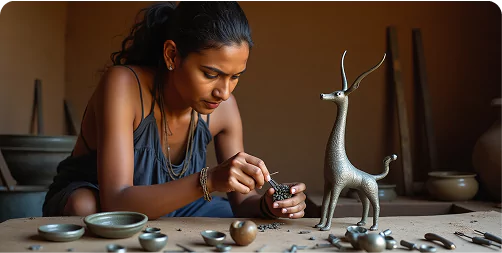
The Origin Story
Bastar Art was born out of the small tribal communities of central India, where art was a key part of rituals and daily life. The first sightings of Bastar art are as old as 1000 years. Centuries passed by, and now this complex art that thrived on making farming and hunting tools has developed, but its essence is still the same—preserving the heritage of the region in sculptures, figurines, masks, and ornaments.

The Present
In the heart of Chhattisgarh, Bastar Art still finds its furnace in small huts, thanks to the unwavering dedication of indigenous craftsmen. Today, several indigenous groups, including Mariya, Muriya, and Ghasiya tribes, are leading the legacy of the past. Their commitment ensures that this traditional craft not only survives but also finds relevance in contemporary settings. If you are fond of traditional artefacts that showcase our rich culture, explore the amazing art pieces authentically made by tribal artisans.

Preserving The Tradition
The Contribution Of Bastar Tribes
The decades-old tradition of Bastar art and craft is kept alive by the unrecognised heroes of small tribal communities of central India, including Ghasiya, Gond, Maria, Muria, and more. Despite modern challenges, the artisans of Bastar remain steadfast in their mission to preserve their ancestral craft. Through their simple yet unique artworks, they embed art and daily life into each strike on the scrap metal.
Art That Echoes Tradition
Protecting The Fading Heritage
From the dense forests of Bastar emerges art that tells stories of its people. Each sculpture of wrought iron is a testament to a tradition that values authenticity, community, and artistic integrity.

Ethnic India Handicrafts
Explore The Authentic Tribal Craftsmanship
Browse through our exquisite art collection featuring Bastar art pieces handcrafted by the Bastar tribes. Each art piece is remarkably handcrafted by tribal artisans of central India. The handmade artefacts are made using traditional techniques, showcasing the rich legacy of Indian heritage. Enhance your decor with traditionally handcrafted items, and contribute to preserving the rich art history of India.
All About Bastar Art
Frequently Asked Questions
Curious about Bastar art? Explore our FAQs to discover more about this craft, process, and the people behind each masterpiece.
When did the Bastar art come into existence?
When did the Bastar art come into existence?
The origins of Bastar art can be traced back thousands of years ago in the dense forests and grasslands of central India.
How long is the process of making Bastar artefacts?
How long is the process of making Bastar artefacts?
The making of Bastar art pieces greatly depends on the size and complexity of the art piece. Some smaller pieces can be made in a few days, whereas complex designs can take up to a couple of months.
What materials are used in Bastar art?
What materials are used in Bastar art?
The Bastar art pieces are made using natural materials, including wood, bamboo, wrought iron, chisels, a furnace, hammer, forceps, and tongs.
Which tribal communities craft Bastar artefacts traditionally?
Which tribal communities craft Bastar artefacts traditionally?
The tribal communities of Chhattisgarh, including Ghasiya, Gond, Muria, and Maria, are renowned artisans of Bastar art.
Where can I buy authentic Bastar art pieces?
Where can I buy authentic Bastar art pieces?
If you are looking for authentic handmade Bastar artefacts, visit our Bastar art collection. We provide authentic Bastar art pieces traditionally handcrafted by Indian artisans.
- Choosing a selection results in a full page refresh.
- Opens in a new window.







